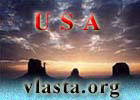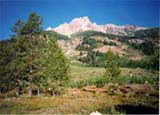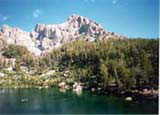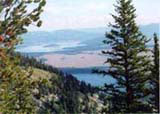From the basin the Tetons rise abruptly, with no interventing foothills, to neck-cracing heghits. The Grand Teton is a magic mountain massive that must impress everybody. East of the range are seven morainal lakes - Jackson Lake, Jenny Lake and more than 100 alpine lakes can be found in the backcountry. Along them is winding through the valley the Snake River. Along tributary streams are favoured feedingg spots for moose and other animals like coyotes, moutain lions, lynx, martens, bobcats, badgers, bears and many smaller animals.
The park's pine forest is home fore elk and mule deer, black and grizzly bears.
This mountains range is the youngest of all Rocky Mountains rangers. Less then 10 million years old, geologically the Tetons are mere babes. The rest of Rockkies average 60 million years in age. The highest peak Grand Teton is high 4 197 m. Amphitheater Lake that I visited is situated in an altitude of 3300 m n.m.
Park headquartes adjoins Moose Visitor center. Colter Bay Visitor Center exhibits an extensive collection in its Indian Arts Museum and offers audiovisual programs. Trails traverse the valley and mountains for more than 200 miles. Their lengths vary from hikes of a few minutes to several days.
This national park follows with Yellowstone. Entrance feed is valid for both of them. It is similar to Europe's mountain. The first visitors came about 10 000 years ago. In more modern times the region has been home to such Native Americans like the Shoshones, the Blackfeet and Gros Ventres. They were nomads, following the annual game migrations and establishing seasonal campsites. Jackson Hole east of the Tetons was buffer zone between territories claimed by the various tribes. The Shoshone called this moutains range "many pinnacles" and were for them secred.






